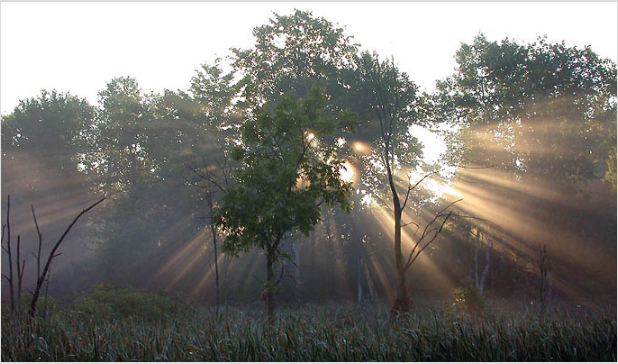Forest rays
Forest Rays: The Enchanting Phenomenon of Sunlit Shafts in the Misty Woods
When walking through a misty forest, you may have experienced a mesmerizing sight: rays of sunlight piercing through the canopy and creating an ethereal display of light and shadow. These captivating phenomena are known as forest rays, and they occur when sunlight filters through gaps in the tree branches and foliage, illuminating the suspended moisture particles in the air. In this article, we will delve deeper into the science behind forest rays, exploring their formation, characteristics, and the magical ambiance they create in nature's serene settings.
The Formation of Forest Rays
Forest rays are a result of the interaction between sunlight, airborne moisture particles, and the obstructing foliage of trees. As sunlight reaches the forest, it encounters various obstacles in its path, such as leaves, branches, and trunks. These natural barriers create gaps and openings that allow some sunlight to pass through. When the sun is at a low angle or partially obscured by clouds, the light enters the forest at a slant, increasing the likelihood of it encountering suspended moisture particles.
The Role of Suspended Moisture Particles
The presence of moisture in the air is crucial for the formation of forest rays. When sunlight interacts with suspended water droplets or tiny particles like dust or pollen, it scatters in different directions. This scattering effect is responsible for the visible beams of light that we perceive as forest rays. The suspended particles act as tiny reflectors, redirecting some of the sunlight towards our eyes and creating a visual spectacle.
The Optical Illusion of Converging Rays
One fascinating aspect of forest rays is their apparent convergence towards a single point on the forest floor. This convergence is an optical illusion caused by perspective. Just as parallel train tracks seem to meet at a distance, the diverging rays appear to converge due to the way our eyes perceive depth. In reality, the rays remain parallel but become progressively fainter as they travel further from their source.
The Three-Dimensional Nature of Forest Rays
Contrary to their appearance, forest rays are not two-dimensional beams of light. Instead, they are three-dimensional shafts of sunlit air. The misty atmosphere in the forest serves as a canvas for these shafts, allowing us to see their full extent. The interplay between light and air creates an enchanting effect, making the rays appear solid and tangible, as if we could reach out and touch them.
Variations in Forest Rays
Forest rays can exhibit a range of variations depending on atmospheric conditions and the density of suspended particles. In denser forests with a higher concentration of moisture or particulate matter, the rays may appear more distinct and pronounced. On misty mornings or after rainfall, when the air is saturated with moisture, the rays can appear thicker and more vibrant. Additionally, the angle at which sunlight enters the forest can influence the angle and direction of the rays, leading to unique patterns and configurations.
The Aesthetic Beauty of Forest Rays
Beyond their scientific explanation, forest rays hold immense aesthetic appeal. They create a sense of wonder and tranquility, transforming the woodland environment into a mystical realm. The interplay of light and shadow casts an enchanting spell on the surroundings, evoking a sense of serenity and reverence for nature. Photographers often seek out forest rays as subjects, capturing their ethereal beauty and creating stunning visual compositions that transport viewers into a realm of magic and imagination.
Similar Atmospheric Optical Phenomena
While forest rays are undoubtedly captivating, they are not the only atmospheric optical phenomena that grace our natural landscapes. Nature offers a multitude of enchanting visual displays, each with its own unique characteristics. Some other notable phenomena include:
- Crepuscular Rays: These are similar to forest rays but occur when sunlight filters through gaps in clouds or mountain ranges, casting beams of light onto the Earth's surface.
- Glory: A circular halo of light that appears opposite the sun when water droplets scatter sunlight back towards the observer.
- Halo: A ring of light encircling the sun or moon, caused by the refraction and reflection of light by ice crystals in the atmosphere.
- Rainbow: A circular arc of colors formed by the refraction, dispersion, and reflection of sunlight in raindrops.
The Importance of Preserving Natural Environments
Forest rays serve as a reminder of the delicate balance between nature and human impact. They thrive in undisturbed forests where sunlight, moisture, and foliage coexist harmoniously. However, deforestation, pollution, and climate change pose significant threats to these pristine ecosystems. By appreciating the beauty of forest rays, we are reminded of the importance of preserving our natural environments, ensuring that future generations can also witness these awe-inspiring phenomena.
Experiencing the Magic of Forest Rays
To fully experience the magic of forest rays, immerse yourself in a misty woodland during early morning or late afternoon when the sun is at a low angle. Find a spot where sunlight filters through the trees and watch as the rays dance through the air, creating an enchanting spectacle of light and shadow. Take a moment to appreciate the tranquility and beauty of nature, allowing yourself to be captivated by the ephemeral charm of forest rays.

This image by Lauri Kangas (site) taken on a misty morning in September '03 really shows that rays are three dimensional shafts of sunlit air. ©2003 Lauri Kangas, shown with permission.
Note: this article has been automatically converted from the old site and may not appear as intended. You can find the original article here.
Reference Atmospheric Optics
If you use any of the definitions, information, or data presented on Atmospheric Optics, please copy the link or reference below to properly credit us as the reference source. Thank you!
-
<a href="https://atoptics.co.uk/blog/forest-rays/">Forest rays </a>
-
"Forest rays ". Atmospheric Optics. Accessed on November 26, 2024. https://atoptics.co.uk/blog/forest-rays/.
-
"Forest rays ". Atmospheric Optics, https://atoptics.co.uk/blog/forest-rays/. Accessed 26 November, 2024
-
Forest rays . Atmospheric Optics. Retrieved from https://atoptics.co.uk/blog/forest-rays/.